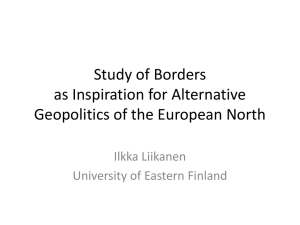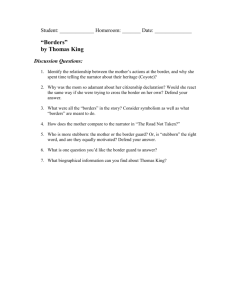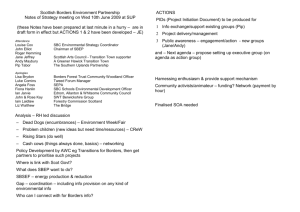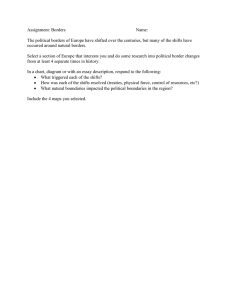Term 1 Week 1
advertisement
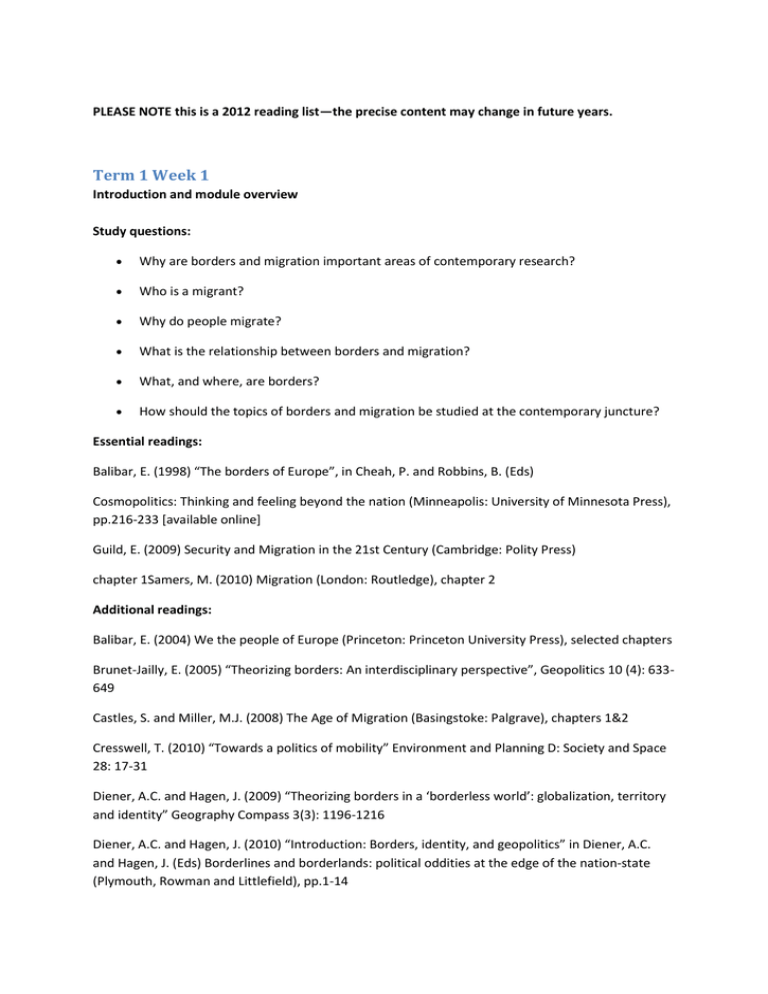
PLEASE NOTE this is a 2012 reading list—the precise content may change in future years. Term 1 Week 1 Introduction and module overview Study questions: Why are borders and migration important areas of contemporary research? Who is a migrant? Why do people migrate? What is the relationship between borders and migration? What, and where, are borders? How should the topics of borders and migration be studied at the contemporary juncture? Essential readings: Balibar, E. (1998) “The borders of Europe”, in Cheah, P. and Robbins, B. (Eds) Cosmopolitics: Thinking and feeling beyond the nation (Minneapolis: University of Minnesota Press), pp.216-233 [available online] Guild, E. (2009) Security and Migration in the 21st Century (Cambridge: Polity Press) chapter 1Samers, M. (2010) Migration (London: Routledge), chapter 2 Additional readings: Balibar, E. (2004) We the people of Europe (Princeton: Princeton University Press), selected chapters Brunet-Jailly, E. (2005) “Theorizing borders: An interdisciplinary perspective”, Geopolitics 10 (4): 633649 Castles, S. and Miller, M.J. (2008) The Age of Migration (Basingstoke: Palgrave), chapters 1&2 Cresswell, T. (2010) “Towards a politics of mobility” Environment and Planning D: Society and Space 28: 17-31 Diener, A.C. and Hagen, J. (2009) “Theorizing borders in a ‘borderless world’: globalization, territory and identity” Geography Compass 3(3): 1196-1216 Diener, A.C. and Hagen, J. (2010) “Introduction: Borders, identity, and geopolitics” in Diener, A.C. and Hagen, J. (Eds) Borderlines and borderlands: political oddities at the edge of the nation-state (Plymouth, Rowman and Littlefield), pp.1-14 Grundy-Warr, C and Schofield, C. (2005) “Reflections on the relevance of classical approaches and contemporary priorities in boundary studies”, Geopolitics 10 (4): 606-632 van Houtum, H. (2005) “The geopolitics of borders and boundaries”, Geopolitics 10 (4): 672-679 Hyndman, J. (1997) “Border crossings”, Antipode 29(2): 149-176 Hyndman, J. (2012) “The geopolitics of migration and mobility”, Geopolitics 17(2): 243-255 Kolosoff, V. (2005) “Border Studies: Changing perspectives and theoretical approaches”, Geopolitics 10 (4): 606-632 Kopper, A. (2012) “The imaginary of borders: From a colouring book to Cezanne’s paintings”, International Political Sociology 6(3): 277-293 Massey, D. (1993) “Power-Geometry and a Progressive Sense of Place’”, in Bird, J., Curtis, B., Putnam, T., Robertson, G. and Tickner, L. (Eds) Mapping the Futures: Local Cultures, Global Change (London: Routledge), pp. 59–69 Newman, D. (2011) “Contemporary research agendas in border studies: An overview”, in WastlWalter, D. (Ed.) The Ashgate Companion to Border Studies (Farnham: Ashgate), pp. 33-47 Passi, A. (2005) “Generations and the ‘development’ of border studies”, Geopolitics 10 (4): 663-671 Paasi, A. (2011) “A border theory: An unattainable dream or a realistic aim for border scholars?” in Wastl-Walter, D. (Ed.) The Ashgate Companion to Border Studies (Farnham: Ashgate), pp. 11-31Popescu, G. (2011) Bordering and Ordering the Twenty-first Century: Understanding Borders (Lanham MD: Rowman and Littlefield), ch 1 Parker, N., Vaughan-Williams, N. et al. (2009) “Lines in the sand? Towards and agenda for critical border studies”, Geopolitics 14(3): 582-587 Rumford, C. (2012) “Towards a multiperspectival perspective on borders”, Geopolitics 17(4): 887902
